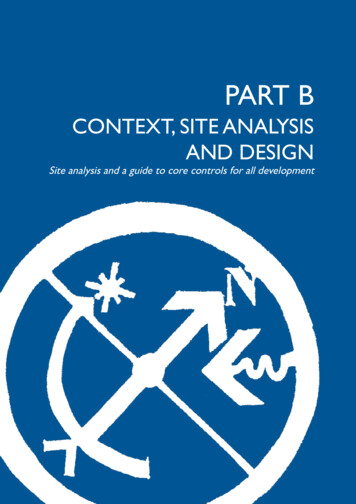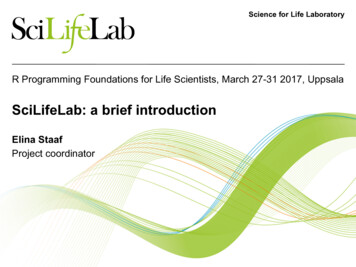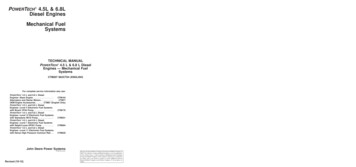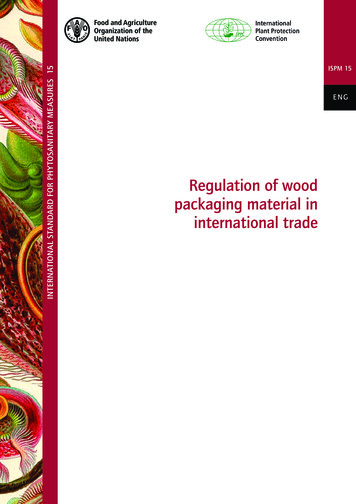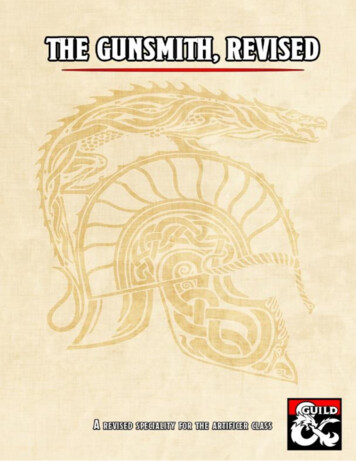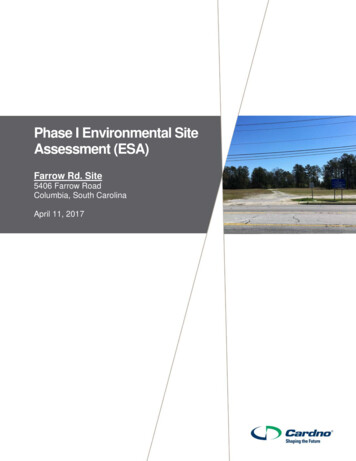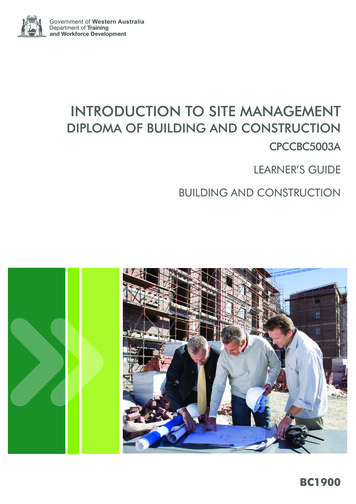
Transcription
This PDF file contains most of the text of the Web exhibit “Einstein – Image and Impact” athttp://www.aip.org/history/einstein. NOT included are many secondary pages reached by clickingon the illustrations, which contain some additional information and photo credits. You must alsovisit the Web exhibit to explore hyperlinks within the exhibit and to other exhibits, and to hearvoice clips, for which the text is supplied here.Brought to you by The Center for History of Physics Copyright 1996-2004 - American Institute of PhysicsSite created Nov. 1996, revised May 2004http://www.aip.org/history/einstein/Page 1 of 93
Table of ContentsFormative Years IWas Einstein’s Brain Different?Formative Years IIFormative Years IIIFormative Years IVThe Great Works IAtoms in a Crystal E mc2Einstein Explains the Equivalence of Energy and MatterThe Great Works IIWorld Fame IA Gravitational Lens World Fame IIPublic Concerns IPublic Concerns IIEinstein Speaks on the Fate of the European JewsPublic Concerns IIIThe Quantum and the Cosmos IYou’re Looking at Quanta The Quantum and the Cosmos IIA Black Hole The Quantum and the Cosmos: At HomeThe Nuclear Age IThe Nuclear Age IIEinstein Speaks on Nuclear Weapons and World Peace Nuclear Age: At HomeScience and Philosophy ICan the Laws of Physics be Unified?Science and Philosophy IIThe World As I See It, An Essay By EinsteinEinstein’s Third paradise, By Gerald HoltonEinstein’s Time, By Peter GalisonHow Did Einstein Discover Relativity? By John StachelEinstein on the Photoelectric Effect, By David CassidyEinstein on Brownian Motion, By David CassidyAn Albert Einstein ChronologyEinstein Chronology for 1905Off the Net: Books on EinsteinMore Einstein Info & LinksEinstein Site ContentsExhibit Creditshttp://www.aip.org/history/einstein/Page 2 of 4244454754657578818385909293
Einstein's parents, Hermann and Pauline, middle-class Germans."I was the son of entirely irreligious (Jewish) parents," Einstein recalled."There was this huge world out there, independent of us human beings and standing beforeus like a great, eternal riddle, at least partly accessible to our inspection and thought. Thecontemplation of that world beckoned like a liberation."One story Einstein liked to tell about his childhood was of a "wonder" hesaw when he was four or five years old: a magnetic compass. Theneedle's invariable northward swing, guided by an invisible force,profoundly impressed the child. The compass convinced him that therehad to be "something behind things, something deeply hidden." Even as asmall boy Einstein was self-sufficient and thoughtful. According tofamily legend he was a slow talker at first, pausing to consider what hewould say. His sister remembered the concentration and perseverancewith which he would build up houses of cards to many stories. The boy'sThe house where Einstein was born. thought was stimulated by his uncle, an engineer, and by a medicalstudent who ate dinner once a week at the Einsteins'."At the age of 12, I experienced a wonder in a booklet dealing with Euclidean planegeometry, which came into my hands at the beginning of a school year. Here wereassertions, as for example the intersection of the three altitudes of a triangle in one point,which -- though by no means evident -- could nevertheless be proved with such certaintythat any doubt appeared to be out of the question. This lucidity and certainty made anindescribable impression on me."http://www.aip.org/history/einstein/Page 3 of 93
Although he got generally good grades (and was outstanding inmathematics), Einstein hated the academic high school he was sent to inMunich, where success depended on memorization and obedience toarbitrary authority. His real studies were done at home with books onmathematics, physics, and philosophy. A teacher suggested Einsteinleave school, since his very presence destroyed the other students' respectfor the teacher. The fifteen-year-old boy did quit school in mid-term tojoin his parents, who had moved to Italy.School class photograph in Munich,1889. Einstein is in the front row,second from right.Was Einstein's Brain Different?Of course it was—people’s brains are as different as their faces. In his lifetime many wondered if there wasanything especially different in Einstein's. He insisted that on his death his brain be made available forresearch. When Einstein died in 1955, pathologist Thomas Harvey quickly preserved the brain and madesamples and sections. He reported that he could see nothing unusual. The variations were within the range ofnormal human variations. There the matter rested until 1999. Inspecting samples that Harvey had carefullypreserved, Sandra F. Witelson and colleagues discovered that Einstein's brain lacked a particular smallwrinkle (the parietal operculum) that most people have. Perhaps in compensation, other regions on each sidewere a bit enlarged—the inferior parietal lobes. These regions are known to have something to do with visualimagery and mathematical thinking. Thus Einstein was apparently better equipped than most people for acertain type of thinking. Yet others of his day were probably at least as well equipped—Henri Poincar andDavid Hilbert, for example, were formidable visual and mathematical thinkers, both were on the trail ofrelativity, yet Einstein got far ahead of them. What he did with his brain depended on the nurturing of familyand friends, a solid German and Swiss education, and his own bold personality.A late bloomer: Even at the age of nine Einstein spoke hesitantly, and his parents feared that he was belowaverage intelligence. Did he have a learning or personality disability (such as "Asperger's syndrome," a mildform of autism)? There is not enough historical evidence to say. Probably Albert was simply a thoughtful andsomewhat shy child. If he had some difficulties in school, the problem was probably resistance to theauthoritarian German teachers, perhaps compounded by the awkward situation of a Jewish boy in a /Page 4 of 93
"It is almost a miracle that modern teaching methods have not yet entirely strangled theholy curiosity of inquiry; for what this delicate little plant needs more than anything,besides stimulation, is freedom."Einstein's family had moved to Italy to try to establish a business, and he joinedthem for a glorious half year of freedom from work and anxiety. In 1895 he tookthe entrance examination for the Swiss Federal Institute of Technology -- and hefailed. He was advised to study at a Swiss school in Aarau; here his teachers werehumane and his ideas were set free. His thoughts turned to the theory ofelectromagnetism formulated by James Clerk Maxwell, seldom taught even inuniversities at the turn of the century.Einstein with his sister.From a classroom essay Einstein wrote in French at the age of 16,explaining why he would like to study theoretical mathematics orphysics: "Above all it is my individual disposition for abstract andmathematical thought, my lack of imagination and practical talent. Myinclinations have also led me to this resolve. That is quite natural; onealways likes to do things for which one has talent. And then there is acertain independence in the scientific profession which greatly pleasesme."The Swiss Federal Institute of Technology ("ETH"), Zurich.http://www.aip.org/history/einstein/Page 5 of 93
Einstein graduated from the Aarau school and entered the Institute ofTechnology in Zurich. Around this time he recognized that physics washis true subject. Only there could he "seek out the paths that led to thedepths." He also realized that he could never be an outstanding student.Fortunately his friend Marcel Grossmann had the conventional traitsEinstein lacked. While Einstein worked in the library or the laboratory,Grossmann took excellent notes at the mathematics lectures, and gladlyshared them with his friend before examinations. Einstein later wrote,"I would rather not speculate on what would have become of mewithout these notes."Einstein with his friend MarcelGrossman (left).Einstein grew familiar with the successes of past scientists who had tried to explain the world entirely throughatoms or fluids, interacting like parts of a machine. But he learned that Maxwell's theory of electricity andmagnetism was defying efforts to reduce it to mechanical processes. Through a new friend, the engineerMichele Besso, Einstein came to the writings of Ernst Mach -- a skeptical critic of accepted ideas in physics.http://www.aip.org/history/einstein/Page 6 of 93
"As a somewhat precocious young man, I was struck by the futility of the hopes and theendeavors that most men chase restlessly throughout life. And I soon realized the cruelty ofthat chase, which in those days was more carefully disguised with hypocrisy and glitteringwords than it is today."The patent office in Bern.After Einstein graduated with an undistinguished record, he made a number of efforts to get a university job,and failed. He found only occasional jobs on the periphery of the academic world. He felt he was a burden onhis none too prosperous family, and wondered if he had been mistaken in trying to become a physicist. Finallyhe got a position at the Swiss Patent Office in Bern. It was "a kind of salvation," he said. The regular salaryand the stimulating work evaluating patent claims freed Einstein. He now had time to devote his thought tothe most basic problems of physics of his time, and began to publish scientific papers.Einstein's closest friend, with whom he walked home from the PatentOffice every day, was Michele Besso. Einstein thought him "the bestsounding board in Europe" for scientific ideas. With other friends inBern, all unknown to the academic world, Einstein met regularly to readand discuss books on science and philosophy. They called themselves theOlympia Academy, mocking the official bodies that dominated science.Michele BessoEinstein's began to attract respect with his published papers (described inthe next section), and in 1909 he was appointed associate professor at theUniversity of Zurich. He was also invited to present his theories beforethe annual convention of German scientists. He met many people he hadknown only through their writings, such as the physicist Max Planck ofBerlin. Soon Einstein was invited to the German University in Prague asfull professor. Here he met a visiting Austrian physicist, Paul Ehrenfest."Within a few hours we were true friends," Einstein recalled, "as thoughour dreams and aspirations were made for each other.”"Academy" members KonradHabricht, Maurice Solovine, ge 7 of 93
At the Zurich Polytechnic a romance had arisen between the handsomeand witty would-be science teacher and a young Serbian woman, MilevaMaric, the only woman in Albert's physics class. Einstein's familyopposed any talk of marriage, even after Mileva gave birth to a daughter(who was apparently given up for adoption). The pair finally married in1903 after Einstein got his job at the Patent Office. Einstein discussedphysics with Mileva, but there is no solid evidence that she made anysignificant contribution to his work. In 1904 a son was born, and asecond in 1910.Einstein, his wife Mileva, andtheir son.Through letters, visits, and science meetings, Einstein came to knowmost of the major physicists of Europe (there were not many in thosedays). In 1912 Einstein was invited back to the Swiss Federal Institute ofTechnology as professor. Here he rejoined his old friend MarcelGrossmann, now professor of mathematics. With Grossmann's aid,Einstein studied the mathematical theories and techniques which hefound necessary for his work toward a new theory of gravitation.Meanwhile, Einstein was being introduced to a different sort of world byanother friend, Friedrich Adler: the world of the Second International andits attempt to halt the growth of international rivalries in Europe.Einstein in 1912In 1914, the German government gave Einstein a senior research appointment in Berlin, along with amembership in the prestigious Prussian Academy of Sciences. When Einstein had left his native land as ayouth, he had renounced German citizenship and all of the militarist German society. But Berlin -- with noteaching duties and a galaxy of top scientists for colleagues -- could not be resisted. It was the highest level ascientific career could ordinarily reach."With such fame, not much time remains for his wife," Mileva complained. "I am very starved for love."Einstein felt suffocated in the increasingly strained and gloomy relationship. He found solace in a love affairwith his cousin, Elsa Löwenthal. Mileva and Albert separated in 1914, after bitter arguments, and divorced in1919. That same year he married Elsa, and settled in with her and her two grown daughters by a previousmarriage. "The Lord has put into him so much that's beautiful, and I find him wonderful," Elsa later wrote,"even though life at his side is enervating and difficult." (Click here for more on Einstein at home.)http://www.aip.org/history/einstein/Page 8 of 93
"A storm broke loose in my mind."Einstein sent to the Annalen der Physik, the leading German physics journal, apaper with a new understanding of the structure of light. He argued that lightcan act as though it consists of discrete, independent particles of energy, insome ways like the particles of a gas. A few years before, Max Planck's workhad contained the first suggestion of a discreteness in energy, but Einsteinwent far beyond this. His revolutionary proposal seemed to contradict theuniversally accepted theory that light consists of smoothly oscillatingelectromagnetic waves. But Einstein showed that light quanta, as he called theparticles of energy, could help to explain phenomena being studied byexperimental physicists. For example, he made clear how light ejectselectrons from metals.Einstein in the patent office.The Annalen der Physik received another paper from Einstein. The wellknown kinetic energy theory explained heat as an effect of the ceaselessagitated motion of atoms; Einstein proposed a way to put the theory to anew and crucial experimental test. If tiny but visible particles weresuspended in a liquid, he said, the irregular bombardment by the liquid'sinvisible atoms should cause the suspended particles to carry out a randomjittering dance. Just such a random dance of microscopic particles had longsince been observed by biologists (It was called "Brownian motion," anunsolved mystery). Now Einstein had explained the motion in detail. He hadreinforced the kinetic theory, and he had created a powerful new tool forstudying the movement of atoms.Einstein discovered lightquanta by ponderingexperiments on particlesdiscovered only a few yearsearlier. See our Web exhibit,The Discovery of theElectron."When the Special Theory of Relativity began to germinate in me, I was visited by all sortsof nervous conflicts. I used to go away for weeks in a state of e 9 of 93
Einstein sent the Annalen der Physik a paper on electromagnetism andmotion. Since the time of Galileo and Newton, physicists had known thatlaboratory measurements of mechanical processes could never show anydifference between an apparatus at rest and an apparatus moving at constantspeed in a straight line. Objects behave the same way on a uniformly movingship as on a ship at the dock; this is called the Principle of Relativity. Butaccording to the electromagnetic theory, developed by Maxwell and refinedby Lorentz, light should not obey this principle. Their electromagnetic theorypredicted that measurements on the velocity of light would show the effects ofmotion. Yet no such effect had been detected in any of the ingenious anddelicate experiments that physicists had devised: the velocity of light did notvary.Einstein had long been convinced that the Principle of Relativity must applyto all phenomena, mechanical or not. Now he found a way to show that thisprinciple was compatible with electromagnetic theory after all. As Einsteinlater remarked, reconciling these seemingly incompatible ideas required"only" a new and more careful consideration of the concept of time. His newtheory, later called the special theory of relativity, was based on a novelanalysis of space and time -- an analysis so clear and revealing that it can beunderstood by beginning science students.Einstein reported a remarkable consequence of his special theory of relativity:if a body emits a certain amount of energy, then the mass of that body mustdecrease by a proportionate amount. Meanwhile he wrote a friend, "Therelativity principle in connection with the Maxwell equations demands thatthe mass is a direct measure for the energy contained in bodies; light transfersmass. This thought is amusing and infectious, but I cannot possibly knowwhether the good Lord does not laugh at it and has led me up the gardenpath." Einstein and many others were soon convinced of its truth. Therelationship is expressed as an equation: E mc2.http://www.aip.org/history/einstein/Page 10 of 93Time and motion: the oldclock tower and an electrifiedtrolley in Bern.
Atoms in a Crystal.This is an image of silicon atoms arranged on a face of acrystal. It is impossible to "see" atoms this way usingordinary light. The image was made by a ScanningTunneling Microscope, a device that "feels" the cloud ofelectrons that form the outer surface of atoms, rather as aphonograph needle feels the grooves in a record.It had long been suspected that crystals are made ofatoms lined up in neat arrays. But at the start of the 20thcentury there was no way to actually see them. Somescientists thought the "atom" in physics theories might bemerely a sort of abstract device useful for computations.Einstein's paper gave one of the first convincing proofsthat atoms do exist as real objects.http://www.aip.org/history/einstein/Page 11 of 93
"In light of knowledge attained, the happy achievement seems almost a matter of course,and any intelligent student can grasp it without too much trouble. But the years of anxioussearching in the dark, with their intense longing, their alterations of confidence andexhaustion and the final emergence into the light -- only those who have experienced it canunderstand it."Einstein's theories sprang from a ground of ideas prepared by decades of experiments. One of the most striking,in retrospect, was done in Cleveland, Ohio, by Albert Michelson and Edward Morley in 1887. Their apparatus,shown above, was a massive stone block with mirrors and crisscrossing light beams, giving an accuratemeasurement of any change in the velocity of light. Michelson and Morley expected to see their light beamsshifted by the swift motion of the earth in space. To their surprise, they could not detect any change. It isdebatable whether Einstein paid heed to this particular experiment, but his work provided an explanation of theunexpected result through a new analysis of space and time.As noted on the previous page, when Einstein used his equations to study the motion of a body, they pointedhim to a startling insight about the body's mass and energy.http://www.aip.org/history/einstein/Page 12 of 93
The deep connection Einstein discovered between energy and mass isexpressed in the equation E mc2. Here E represents energy, mrepresents mass, and c2 is a very large number, the square of the speedof light. Full confirmation was slow in coming. In Paris in 1933, Irèneand Frédéric Joliot-Curie took a photograph showing the conversion ofenergy into mass. A quantum of light, invisible here, carries energy upfrom beneath. In the middle it changes into mass -- two freshly createdparticles which curve away from each other.Conversion of energy into massMeanwhile in Cambridge, England, the reverse process was seen: theconversion of mass into pure energy. With their apparatus JohnCockcroft and E.T.S. Walton broke apart an atom. The fragments hadslightly less mass in total than the original atom, but they flew apart withgreat energy.http://www.aip.org/history/einstein/Page 13 of 93
Einstein Explains the Equivalence ofEnergy and Matter"It followed from the special theory of relativity that mass and energyare both but different manifestations of the same thing -- a somewhatunfamiliar conception for the average mind. Furthermore, the equationE is equal to m c-squared, in which energy is put equal to mass,multiplied by the square of the velocity of light, showed that very smallamounts of mass may be converted into a very large amount of energyand vice versa. The mass and energy were in fact equivalent, accordingto the formula mentioned before. This was demonstrated by Cockcroftand Walton in 1932, n/Page 14 of 93
"The four men who laid the foundations of physics on which I have been able to construct my theory. "GalileoIsaac NewtonJames Clerk MaxwellHendrik Antoon LorentzAs early as 1907, while Einstein and others explored the implications of his special theory of relativity, he wasalready thinking about a more general theory. The special theory had shown how to relate the ge 15 of 93
made in one laboratory to the measurements made in another laboratory moving in a uniform way with respectto the first laboratory. Could he extend the theory to deal with laboratories moving in arbitrary ways, speedingup, slowing down, changing direction? Einstein saw a possible link between such accelerated motion and thefamiliar force of gravity. He was impressed by a fact known to Galileo and Newton but not fully appreciatedbefore Einstein puzzled over it. All bodies, however different, if released from the same height will fall withexactly the same constant acceleration (in the absence of air resistance). Like the invariant velocity of light onwhich Einstein had founded his special theory of relativity, here was an invariance that could be the startingpoint for a theory."The physicist cannot simply surrender to the philosopher the critical contemplation of thetheoretical foundations; for he himself knows best and feels most surely where the shoepinches. he must try to make clear in his own mind just how far the concepts which heuses are justified. The whole of science is nothing more than a refinement of everydaythinking."As he often did in his work, Einstein used a "thought experiment." Suppose that a scientist is enclosed in a largebox somewhere, and that he releases a stone. The scientist sees the stone fall to the floor of the box with aconstant acceleration. He might conclude that his box is in a place where there is a force of gravity pullingdownward. But this might not be true. The entire box could be free from gravity, but accelerating upward inempty space on a rocket: the stone could be stationary and the floor rising to meet it. The physicist in the boxcannot, Einstein noted, tell the difference between the two cases. Therefore there must be some profoundconnection between accelerated motion and the force of gravity. It remained to work out this connection.Einstein began to search for particular equations -- ones that would relate the measurements made by twoobservers who are moving in an arbitrary way with respect to one another. The search was arduous, with entireyears spent in blind alleys. Einstein had to master more elaborate mathematical techniques than he had everexpected to need, and to work at a higher level of abstraction than ever before. His friend Michele Besso gavecrucial help here. Meanwhile his life was unsettled. He separated from his wife. And he began to participate inpolitics after the First World War broke out."I have just completed the most splendid work of my life."--to his son Hans Albert, 1915Success in his theoretical work was sealed in 1915. The new equations of gravitation had an essential logicalsimplicity, despite their unfamiliar mathematical form. To describe the action of gravity, the equations showedhow the presence of matter warped the very framework of space and time. This warping would determine howan object moved. Einstein tested his theory by correctly calculating a small discrepancy in the motion of theplanet Mercury, a discrepancy that astronomers had long been at a loss to explain.http://www.aip.org/history/einstein/Page 16 of 93
"Dear Mother, -- Good news today. H.A. Lorentz has wired me that the British expeditionshave actually proved the light deflection near the sun."Einstein's new general theory of relativity predicted a remarkable effect:when a ray of light passes near a massive body, the ray should be bent.For example, starlight passing near the sun should be slightly deflectedby gravity. This deflection could be measured when the sun's own lightwas blocked during an eclipse. Einstein predicted a specific amount ofdeflection, and the prediction spurred British astronomers to try toobserve a total eclipse in May 1919. Feverish preparations began as thewar ended. Two expeditions, one to an island off West Africa and theother to Brazil, succeeded in photographing stars near the eclipsed sun.The starlight had been deflected just as Einstein had predicted.In a letter to an astronomer in 1913, Einstein included a sketch (right)that showed how gravity should deflect light near the sun, makingstars appear to shift their positions. A photograph (below) from one ofthe expeditions shows the eclipsed sun. Some stars are circled andartificially enhanced in this reproduction. These apparent positionsdeviated from the positions of the stars photographed when the sunwas elsewhere in the sky. As a ripple a pane of in glass is detectedwhen objects seen through the glass are distorted, so we detect here awarping of space itself.http://www.aip.org/history/einstein/Page 17 of 93
A Gravitational Lens.This photo taken with the HubbleSpace Telescope shows a cluster ofgalaxies. Each of the brightrounded objects contains billions ofstars. The huge concentrated massof the cluster warps space around it,bending the light that comesthrough from galaxies lying farbeyond the cluster. Each of thestreaks and arcs in the photo is asmeared-out image of one of thosedistant galaxies.Measuring the streaks and applying Einstein's equations, physicists can calculate the distribution of matter inthis cluster of galaxies. Astronomers are also using the cluster itself as a sort of telescope. This powerful"gravitational lens" gathers light from galaxies so remote that we could not see them by other means. Some ofthe light you see here originated when the universe was barely a quarter of its present age.http://www.aip.org/history/einstein/Page 18 of 93
"Since that deluge of newspaper articles I have been so flooded with questions, invitations,suggestions, that I keep dreaming I am roasting in Hell, and the mailman is the devileternally yelling at me, showering me with more bundles of letters at my head because Ihave not answered the old ones."Announcement of the eclipse results caused asensation, and not only among scientists. It broughthome to the public a transformation of physics, byEinstein and others, that was overturning establishedviews of time, space, matter, and energy. Einsteinbecame the world's symbol of the new physics. Somejournalists took a perverse delight in exaggerating theincomprehensibility of his theory, claiming that only agenius could understand it. More serious thinkers -philosophers, artists, ordinary educated and curiouspeople -- took the trouble to study the new concepts.These people too chose Einstein as a symbol forthought at its highest.Cartoon"I have become rather like King Midas, except thateverything turns not into gold but into a circus."http://www.aip.org/history/einstein/Page 19 of 93
With his second wife, Elsa, Einstein toured the US in 1921 like a celebrity. His name and face became familiareven in cartoons and /Page 20 of 93
"The state exists for man, not man for the state. The same may be said of science. These areold phrases, coined by people who saw in human individuality the highest human value. Iwould hesitate to repeat them, were it not for the ever recurring danger that they may beforgotten, especially in these days of organization and stereotypes."The outbreak of the First World War brought Einstein's pacifist sympathies into public view. Ninety-threeleading German intellectuals, including physicists such as Planck, signed a manifesto defending Germany's warconduct. Einstein and three others signed an antiwar counter-manifesto. He helped to form a nonpartisancoalition that fought for a just peace and for a supranational organization to prevent future wars. As a Swisscitizen Einstein could feel free to spend his time on theoretical physics, but he kept looking for ways toreconcile the opposing sides. "My pacifism is an instinctive feeling," he said, "a feeling that possesses mebecause the murder of men is disgusting. My attitude is not derived from any intellectual theory but is based onmy deepest antipathy to every kind of cruelty and hatred."Along with Germany's military collapse in November 1918, chaoticworkers' and soldiers' councils proliferated. One of Einstein's lectures atthe University of Berlin was "canceled due to revolution." On November16 Einstein was one of the original signers of a manifesto announcingthe creation of a progressive middle-class party, the German DemocraticParty. After a democratically elected assembly met in Weimar, Einsteinformally accepted German citizenship as a gesture of support for theinfant republic.The 1920 Kapp Putsch, an attemptedcoup by monarchists, was only oneof many disturbances in Berlin.Einstein in Berlin with political figures.http://www.aip.org/history/e
The Quantum and the Cosmos I 27 You’re Looking at Quanta 30 The Quantum and the Cosmos II 31 A Black Hole 32 The Quantum and the Cosmos: At Home 33 The Nuclear Age I 34 The Nuclear Age II 36 Einstein Speaks on Nuclear Weapons and World Peac

